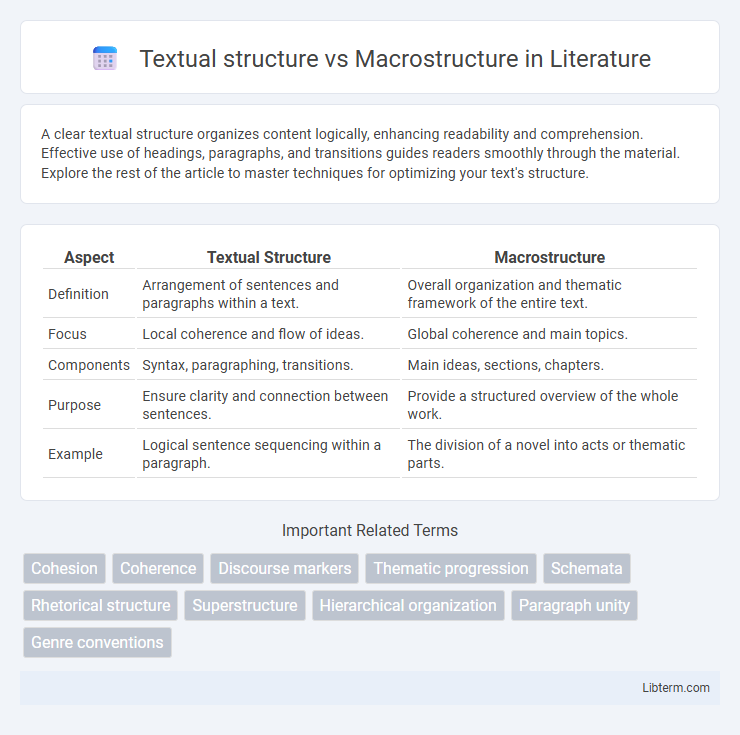A clear textual structure organizes content logically, enhancing readability and comprehension. Effective use of headings, paragraphs, and transitions guides readers smoothly through the material. Explore the rest of the article to master techniques for optimizing your text's structure.
Table of Comparison
| Aspect | Textual Structure | Macrostructure |
|---|---|---|
| Definition | Arrangement of sentences and paragraphs within a text. | Overall organization and thematic framework of the entire text. |
| Focus | Local coherence and flow of ideas. | Global coherence and main topics. |
| Components | Syntax, paragraphing, transitions. | Main ideas, sections, chapters. |
| Purpose | Ensure clarity and connection between sentences. | Provide a structured overview of the whole work. |
| Example | Logical sentence sequencing within a paragraph. | The division of a novel into acts or thematic parts. |
Introduction to Textual Structure and Macrostructure
Textual structure refers to the organization and arrangement of sentences and paragraphs within a text, shaping its coherence and flow. Macrostructure involves the overarching framework or global organization that outlines the main ideas and themes of a text, providing a high-level summary of its content. Understanding both textual structure and macrostructure is essential for analyzing how information is presented and connected from detailed units to the overall meaning.
Defining Textual Structure
Textual structure refers to the organization and arrangement of elements within a text, such as sentences, paragraphs, and sections, which create coherence and guide reader comprehension. It encompasses components like syntax, cohesive devices, and rhetorical patterns that shape the flow and unity of the text at the micro-level. Understanding textual structure is essential for analyzing how information is presented and linked within a single piece of writing.
Understanding Macrostructure in Texts
Macrostructure in texts refers to the overarching framework that organizes and connects the main ideas and themes, providing a coherent global understanding beyond individual sentences or paragraphs. It captures the hierarchical relationships and overall narrative flow, enabling readers to grasp the text's primary message and purpose efficiently. Understanding macrostructure involves recognizing patterns such as topic progression, thematic development, and structural coherence, which are critical for effective comprehension and knowledge synthesis.
Key Differences Between Textual Structure and Macrostructure
Textual structure refers to the organization and arrangement of individual sentences and paragraphs within a text, emphasizing coherence and flow at the micro level. Macrostructure deals with the overall framework and thematic organization of a text, highlighting the main ideas and global meaning that connect smaller units into a cohesive whole. The key difference lies in textual structure focusing on local connections, while macrostructure centers on summarizing and organizing the text's main concepts for comprehensive understanding.
Components of Textual Structure
Textual structure comprises the organization and arrangement of sentences and paragraphs, including components such as coherence, cohesion, and thematic progression. Elements like topic sentences, transitions, and logical sequencing contribute to a well-defined textual structure that aids reader comprehension. Macrostructure, distinct from textual structure, refers to the overall global structure or the main ideas and framework at the discourse level.
Macrostructure: Elements and Functions
Macrostructure in textual analysis refers to the overarching framework that organizes ideas and themes across a text, encompassing elements such as the global topic, main ideas, and hierarchical relationships between concepts. Its primary functions include guiding the reader's understanding by providing coherence, facilitating information retrieval, and supporting the integration of new knowledge within broader contexts. Effective macrostructure enhances comprehension by linking local details to the overall message, ensuring that the text's purpose and key arguments are clearly conveyed.
The Role of Textual Structure in Comprehension
Textual structure organizes information within sentences and paragraphs, providing clear relationships between ideas through elements like headings, topic sentences, and transitions. Macrostructure refers to the overarching framework or global organization of a text, encompassing the main themes and overall coherence. Understanding textual structure enhances comprehension by guiding readers through hierarchical information, enabling efficient retrieval of key details and fostering integration of new knowledge within the larger context.
Macrostructure’s Impact on Discourse Coherence
Macrostructure significantly influences discourse coherence by providing an overarching framework that organizes individual textual structures into a unified whole. It shapes the global meaning of a text through thematic progression, enabling readers to integrate information across sentences and paragraphs. Effective macrostructural design ensures logical flow and clarity, facilitating comprehension and retention in complex discourse.
Analyzing Texts: Practical Applications
Textual structure refers to the organization and arrangement of ideas within a text, including sentence patterns, paragraph development, and coherence mechanisms, crucial for detailed text analysis. Macrostructure involves the overarching framework or global meaning, such as themes, main ideas, and narrative flow, enabling comprehensive understanding of the text's purpose. Analyzing texts through both textual structure and macrostructure enhances skills in summarizing, interpreting, and critiquing written material in practical applications like academic research and content editing.
Conclusion: Integrating Structure for Effective Communication
Textual structure organizes information within individual sentences and paragraphs, ensuring clarity and coherence at the micro level. Macrostructure governs the overall arrangement and hierarchical framework of the entire text, guiding the reader through its main ideas and supporting details. Integrating both textual structure and macrostructure enhances effective communication by creating a cohesive narrative that is easy to follow and logically compelling.
Textual structure Infographic

 libterm.com
libterm.com